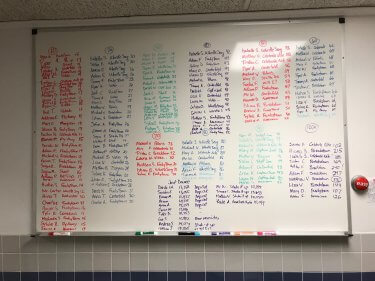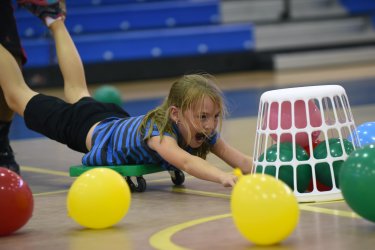50 Million Strong by 2029 is SHAPE America’s commitment to empower all children to lead healthy and active lives through effective health and physical education programs (SHAPE America).
SHAPE America has a bold goal. But it’s one that all of us who teach physical education should be striving to achieve. If 50 million sounds like a huge number, it is! And it’s easy to suggest it’s an unrealistic goal. But in honesty, it’s not so impossible to imagine success if we think about this goal one student at a time.
As the school year winds down and we break for summer, it’s a good time to think about our programs and how we can improve. Where can we add things that give our kids the best chance to be a part of 50 Million Strong? All of us who teach physical education do our best to instill in our students the idea that physical activity is good for them and that they can have fun at the same time. So now, we need to ask ourselves “How can we make our programs even more effective?” The film I’ve shared below shows some of the things we are doing at Mott Road Elementary to help our kids join the “50 Million Strong” club.
Like many of you, we have students who get dropped off early before school begins. A few years ago, we had the idea of opening the gym for an activity we called “Exercise for Excellence.” We wanted the kids to see that this wasn’t just free time in the gym. Instead, we wanted students to make the connection between exercise and their brains and help them realize that having fun moving each day can help them learn better.
Our oldest students (4th graders) get to use the gym each morning for some organized activities. We use this time for them to exercise together in a fun game-like setting. Activities range from bed sheet races, to scooter chariot runs, to a junk-yard game, and countless other ways chosen to get the kids to love moving and playing. The games change daily, with every Friday being “Capture the Flag Friday.” Typically, we have between 20-30 kids each morning.
Our younger students move using our DDR pads or Just Dance games in my office or an adjacent room. We’ll get another 20 or so each day here too. We use the white board outside this room to post the kids’ best scores. We have discovered students are very proud of themselves when they beat their best score and get to hit the “easy” button. One of my 1st graders has been in there all year and he finally got 100 “combos” (correct steps on the DDR pad) in a row. He is now known as “Century Man Schute!” Every one of these early morning movers leaves at the bell to go to their classrooms knowing that they are energized and ready to tackle the day’s activities.

The morning fitness walk shown in the video has evolved from everyone walking the hallways right after announcements, to half the building walking and the other half doing something like GoNoodle in their classrooms. Initially we faced some faculty push back, claiming that we were taking instructional time away from them by doing the 6:00 minute walk. In response, we educated them using literature about the exercise and the brain connection and those colorful brain scan images showing a child’s brain before and after exercise. I told teachers that I was giving them better-prepared students to work with because their brains were more energized and ready to learn.
Now when the classroom teachers get them back, learning is maximized. Throughout the school year I regularly send them different brain-energizing activities they can try with their kids. Because I want to make sure teachers use movement successfully, I share as many different ideas as possible. Many of our teachers have embraced this idea, some by repeating the “jump rope spelling” you saw in the video.
I’ll even try to support our classroom teachers by posting the students’ weekly spelling words in the gym. I have them warm up with a jump rope, with every jump being a letter in their spelling list, or every dribble of a ball, or cradle of a lacrosse stick being a letter in a word. Now students can see how exercise can help their brains learn and remember things that they need to know; in this case, their spelling words!
When our building scheduled allows, we open up our DDR and Just Dance equipment during daily recess. This attracts the kids who don’t choose to move around at recess. Especially during the winter months up here in Central New York, we get kids moving who don’t want to go outside at all. They realize that no one is looking at them because everyone is focused on the game on the screen. We cheer for each other when someone breaks their own record. They use a pedometer to add up their steps and earn small foot tokens for accumulating certain increments of steps.
I’ve had discussions with many people about using technology in a physical education setting. I view technology is just a tool to consider using. If it can help my kids learn what it is that they need to know from my class, then I’ll use it. If not, I simply won’t use it. I want them as active as possible, but I also want them learning as much as possible.
I feel that trying to increase activity time just to be able to say my students are more active, but not organizing the kinds of activities that lead to learning is counter-productive. In fact, it hinders my kids’ chances to join that elusive “50 Million Strong” club. That’s why I feel it’s important to take a moment or two each lesson to use a heart rate monitor, or record steps from a pedometer. Doing this makes each child’s efforts more real and understandable to them. They start discovering things like how much is enough exercise and places where they can add activity into their days.

I do want my students to be active as much as possible especially in the short term. Being healthy and strong are always good things! But for the long term I also want my students to understand the whys behind all this good stuff. I want to create an environment where they all want to return to a safe place where competition is primarily focused on improving on their previous efforts rather than against someone else’s performance.
I also want to create a culture of physical activity in my building where exercise is not conveniently placed in the building’s master schedule two to three times a week for 40 minutes. I want students to learn that being sweaty is not gross; they are “sweat trophies” after all! And I work hard to make sure that both our staff and our students see exercise as something they can enjoy and that it helps them do what they need to do in school every day.
If the goal of the 50 Million Strong commitment is to get our kids active for a lifetime, I feel we must show them that exercise and physical activity isn’t limited to a convenient block in our daily school schedule. Being physically active and healthy is something that will help all students to reach their life goals. Showing them how and why to exercise during our scheduled PE time is good but it’s not enough. What’s really important, is showing students the value of committing to an active and healthy lifestyle. And to me, that’s what 50 Million Strong is all about.

Tom,
Excellent example of a 50 Million Strong school and a 50 Million Strong physical educator. You should submit a case study on the SHAPE America website!
Thanks for the great work you do!
Dr. Fran Cleland
SHAPE America President